Those bananas at the grocery store are nothing compared to the exciting and flavorful cultivars you can grow yourself — if your climate permits. Their flavors range from the vanilla notes of Blue Java to the tartness of the Apple banana, their colors range from light blue to mahogany red, and they're found in shapes ranging from blocky and squat to slender and delicate.
Their leaves can be used to wrap and grill seafood; the flowers can be eaten as vegetables; and in the landscape, their strong form and bold presence are rivaled by few other plants. In other words, you really need to start growing bananas.
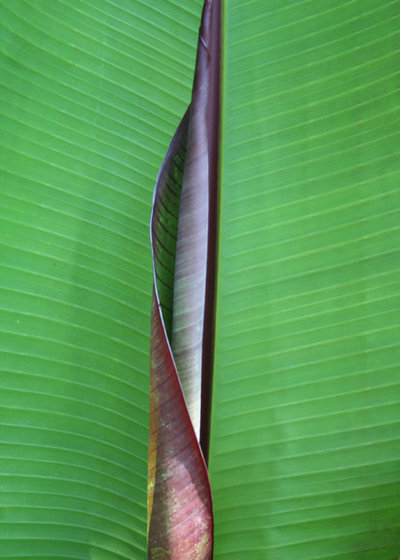 Botanical names: Musa acuminata
Botanical names: Musa acuminata,
Musa balbisana,
Ensete ventricosum (shown)
Common names: Banana, plantain
USDA zones: 8b to 11 (find your zone)
Moisture requirement: Ample water
Light requirement: Full sun
Mature size: 5 to 20 feet tall, depending on the cultivar
Seasonal interest: Year-round except for winters where there are freezes
When to plant: Year-round in zones 9b to 11; spring in zones 7 to 9
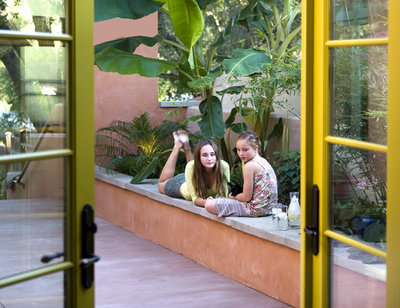
HERE Design and Architecture
Bananas impart a carefree ambience wherever they're planted.
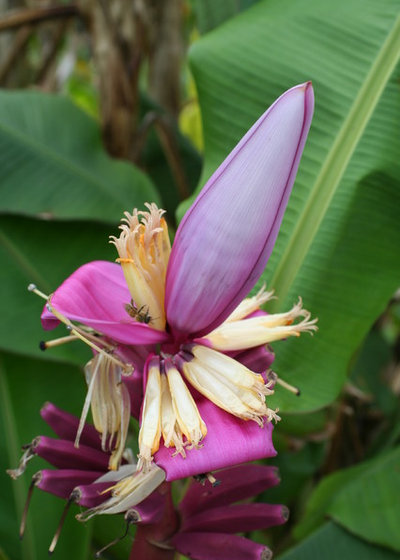 Which Banana Plant Is Right for You?
Which Banana Plant Is Right for You? Some bananas grow only a few feet tall, while others surpass 30 feet. And size isn't the only thing to consider. There are ornamental bananas and edible bananas, sweet bananas and starchy bananas, and even bananas that can be grown in containers.
Ornamental bananas. Not all bananas are grown for the table, and while all of them are attractive enough to be grown as ornamentals, these species are grown exclusively for their looks.
Pink flowering banana (
Musa ornata, zones 8b to 11), shown, produces stunning lavender-pink flowers on upright stalks, held aloft right at eye level.
Chinese yellow banana (
Musella lasiocarpa, zones 7b to 11) is a close relative of the banana and is also grown primarily for its impressive bloom. The
Japanese fiber banana (
Musa basjoo, zones 6 to 11) is the cold-hardiest banana and can be grown in temperate zones with protection.
Abyssinian banana (
Ensete ventricosum, zones 9 to 11) has dramatic upright leaves with prominent ribs.
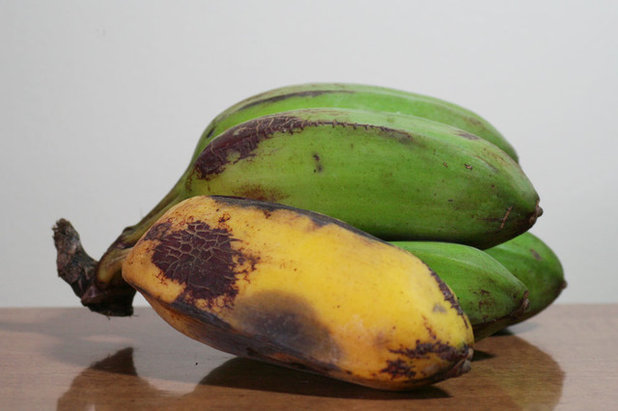 Dessert bananas.
Dessert bananas. Dessert bananas are the most popular, because they're what we're used to eating, but the types of bananas you can grow in your garden are far superior to the ones you'll find at the grocery store.
Double Mahoi (
Musa acuminata 'Double Mahoi', zones 9 to 11) is unique in that it produces two fruiting stems on one plant.
Blue Java (
Musa acuminata 'Blue Java', zones 9 to 11) is also known as the ice cream banana, because its light blue bananas taste similar to vanilla ice cream.
Rajapuri (
Musa acuminata 'Rajapuri', zones 8 to 11) is popular in the coastal and lower U.S. South due to its cold hardiness and sweet fruit. If all you want is the familiar banana of the grocery store, plant
Dwarf Cavendish (
Musa acuminata 'Dwarf Cavendish', zones 8b to 11).
Plantains. Starchy plantain-type bananas are a suitable replacement for potatoes and other starch crops in the tropics and are excellent served up fried. They have found their way into Latin American, Caribbean, African and Southeast Asian cuisines, but most shoppers in Britain and the United States know them only as "green bananas." They do require cooking before being served.
Some choices for your garden include
Ae Ae (
Musa X
paradisiaca 'Ae Ae', zones 10 to 11),
Dwarf Orinoco (
Musa x
paradisiaca 'Dwarf Orinoco', zones 7b to 11) and
Mysore (
Musa x
paradisiaca 'Mysore', zones 10 to 11).
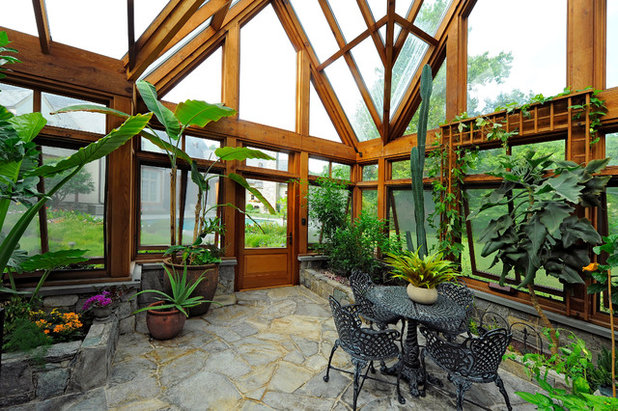
SURROUNDS Landscape Architecture + Construction
How to Use Banana Plants
In containers. Whether you lack the space, live outside the tropics or just need a dramatic focal point in your container arrangements, there are several bananas with the right size for the job.
Super Dwarf Cavendish (
Musa acuminata 'Super Dwarf Cavendish', zones 9b to 11) is an even shorter version of the dwarf Cavendish, reaching only a few feet tall.
Siam Red (
Musa acuminata 'Siam Red', zones 10 to 11) has intense orange-red leaves variegated with green.
Red Abyssinian banana (
Ensete ventricosum 'Maurelli', zones 9a to 11) is a banana relative that also has red leaves, but they are upright and give the plant the appearance of a shuttlecock. They can get quite large but will last a few years in a container.
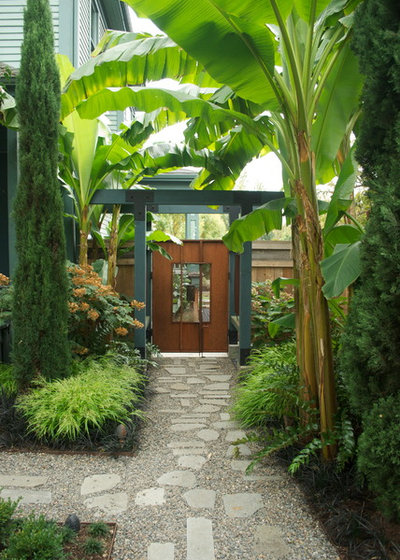
Lilyvilla Gardens
In the landscape. Banana plants look great almost anywhere they're placed, but the biggest consideration when siting them is how big they will eventually get. Since bananas form new stems at their base, things can get crowded rather quickly. Use bananas wherever a strong architectural presence is needed: at the corner of a bed, to mark a curve in a path or to draw attention to an outdoor seating area. Sitting beneath banana leaves during an afternoon shower is one of life's great pleasures, so be sure to place them where they can be enjoyed.
If you're growing edible types, just remember that you will need to harvest the fruit and thin out the declining stems, which means that the plantings (if any) beneath the bananas should be durable enough to handle occasional foot traffic.
Ornamental bananas are ideal as focal points in a bed of perennials or ground covers, and occasionally as specimens surrounded by open space. Smaller types look superb when massed together like cannas.
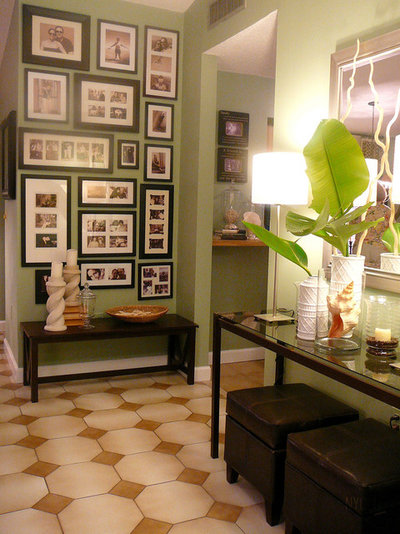
FOCAL POINT STYLING
Decorating with bananas. Let's not overlook how bananas can contribute to the beauty of your home. Banana leaves make a bold statement in large vases or when used as a makeshift table runner or wall ornament. Just be sure to let the sap dry off from the cut end first, as it can cause stains. Banana flowers are beautiful displayed in bowls of water or as centerpieces, as are the banana fruits themselves.
Try using
pink velvet bananas (
Musa velutina, zones 7b to 11) and
red bananas (
Musa acuminata 'Red Dacca', zones 9 to 10) for their small size and unexpected hues. Nothing says tropical style like a freshly cut "hand" of bananas on the kitchen counter.
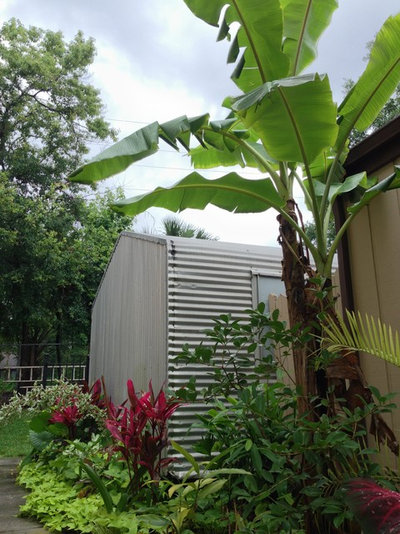 How to Care for Banana Plants
How to Care for Banana PlantsBelieve it or not, bananas are pretty carefree once they're established. Though they are tolerant of many conditions, they thrive best with lots of ample sunlight, moisture and fertilizer.
Planting. Amend the planting site with plenty of compost or topsoil and keep the banana watered, especially during its first months in the ground. Feed it on a regular schedule according to the fertilizer's label instructions.
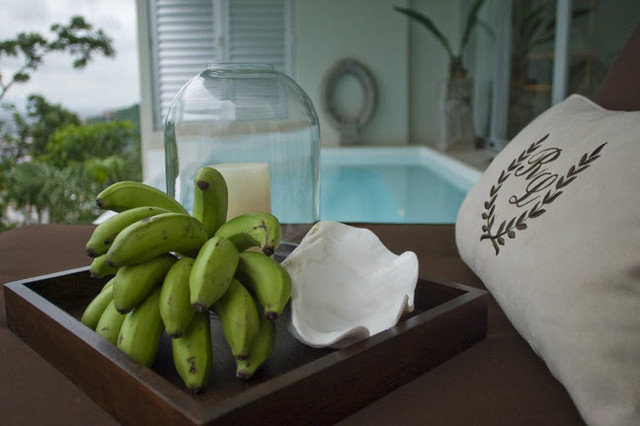
At Home and Company
Harvest. Though each banana stem will take two to three years to bloom and produce fruit, they all will do so throughout the year, with established clumps producing more fruit than you'll know what to do with.
When the banana blooms, the flower (rather a collection of flowers) will hang downward and form bananas as it descends. Remove the banana "hands" with a sharp knife or machete as soon as they reach a mature size, leaving the bloom in place to form new fruits. When the bloom is spent, the stem will die. Cut the entire stem to the ground, allowing the other stems to take its place. The stem can be chopped up and spread over the planting site as an effective mulch.





